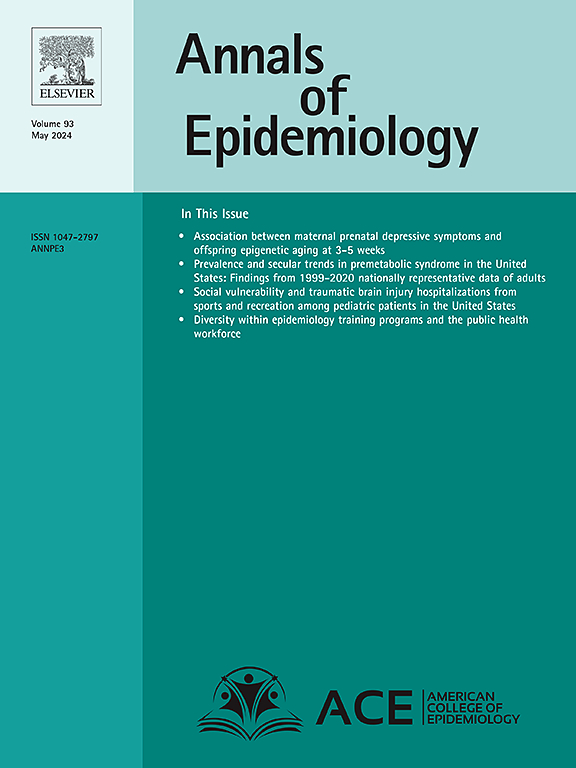两大洲三个国家的南亚缺血性中风患者的缺血性心脏病:BRAINS研究
IF 3.3
3区 医学
Q1 PUBLIC, ENVIRONMENTAL & OCCUPATIONAL HEALTH
引用次数: 0
摘要
背景:缺血性心脏病(IHD)和心脏代谢危险因素已经在欧洲血统中进行了广泛的研究,但它们在占世界人口约20%的南亚人中更为常见。我们探讨了生活在英国、印度和卡塔尔的南亚中风患者与英国白人中风患者在IHD和累积代谢谱方面的差异。方法:该研究包括首次缺血性中风的英国白人患者和居住在英国、印度和卡塔尔的南亚人,他们来自正在进行的大型脑卒中DNA生物库(BRAINS)国际医院脑卒中研究。结果:我们分析了4359例患者,其中1575例为英国白人(WB), 1135例为英国南亚人(BSA), 1084例为印度南亚人(ISA), 565例为卡塔尔南亚人(QSA)。来自BSA和ISA背景的卒中患者的IHD患病率为9.5% (95%CI: 6.2-12.9)。结论:与留在次大陆的患者相比,南亚缺血性卒中移民具有更高的IHD患病率以及更多的累积心脏代谢危险因素。拥有大量南亚移民人口的国家应重点开展公共卫生运动,以减轻他们的高心脏代谢风险。本文章由计算机程序翻译,如有差异,请以英文原文为准。
Ischemic heart disease among South Asians with ischaemic stroke in three countries across two continents: the BRAINS study
Background
Ischaemic heart disease (IHD) and cardiometabolic risk factors have been extensively investigated in those of European descent, yet they are more common among South Asians who make up around 20% of the world’s population. We explored the differences in IHD and cumulative metabolic profile in South Asians with stroke living in the UK, India and Qatar, compared with white British stroke patients.
Methods
The study included first-ever ischemic stroke white British patients and South Asians living in UK, India and Qatar from the ongoing large Bio-Repository of DNA in Stroke (BRAINS) international hospital-based stroke study.
Results
We analysed 4359 patients of which 1575 were white British (WB) UK residents, 1135 British South Asians (BSA), 1084 South Asians in India (ISA), and 565 South Asians in Qatar (QSA). Stroke patients from BSA and ISA background had a 9.5% (95%CI: 6.2-12.9, P<0.001) and 15.8% (95%CI: 13.1–28.9, P<0.001) higher prevalence of IHD respectively, compared to WB patients. Adjusting for traditional stroke risk factors, BSA patients continued to display an increased association of IHD compared to WB patients: OR=1.59 (95%CI: 1.25–2.02, P<0.001). Among South Asian ethnicity, compared to ISA, BSA had an almost twice the association of IHD: OR=1.83 (95%CI: 1.37-2.45, P<0.001). The OR for the presence of 2, or ≥3 cumulative cardiometabolic risk factors was 2.55 (95%CI: 2.02–3.23, P<0.001), and 3.86 (95%CI: 3.02–4.95, P<0.001) for South Asians (ISA, BSA, QSA) compared to WB patients, respectively.
Conclusion
South Asian ischaemic stroke immigrants have a higher prevalence of IHD as well as more cumulative cardiometabolic risk factors compared to those who remain on the subcontinent. Countries with large immigrant South Asian populations should focus public health campaigns to mitigate their high cardiometabolic risk profiles.
求助全文
通过发布文献求助,成功后即可免费获取论文全文。
去求助
来源期刊

Annals of Epidemiology
医学-公共卫生、环境卫生与职业卫生
CiteScore
7.40
自引率
1.80%
发文量
207
审稿时长
59 days
期刊介绍:
The journal emphasizes the application of epidemiologic methods to issues that affect the distribution and determinants of human illness in diverse contexts. Its primary focus is on chronic and acute conditions of diverse etiologies and of major importance to clinical medicine, public health, and health care delivery.
 求助内容:
求助内容: 应助结果提醒方式:
应助结果提醒方式:


